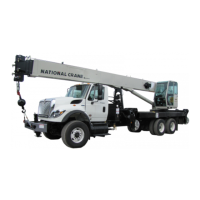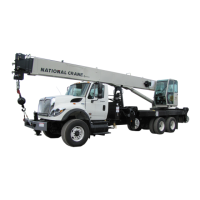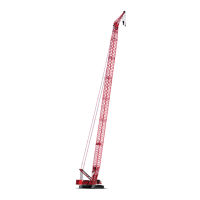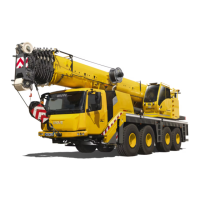INTRODUCTION 14000 SERVICE MANUAL
1-34
Published 09-10-14, Control # 065-24
DRUM 4 (BOOM HOIST) SYSTEM
See Figure 1-20 and Figure 1-21 for the following procedure.
Drum 4 (boom hoist) is mounted at rear of rotating bed and
controls the boom when the crane is configured as a
liftcrane. One hydraulic pump drives one motor gearbox at
end of drum 4. Hydraulic connections between pump and
motor form a closed-loop system that is controlled with
control handle movement and node controllers. Drum 4
control handle is inoperable when park brake is applied.
In liftcrane configuration, drum 4 (boom hoist) is controlled
with control handle on left side console. In luffing jib
configuration, boom hoist is controlled with control handle 3/
4 on far right of right side console, while the luffing jib hoist is
controlled by control handle on left side console.
Charge pressure from system pump supplies hydraulic
make-up fluid to closed-loop. Low-side pressure supplies
hydraulic pilot pressure to operate motor servo. A pressure
sender in high-pressure side of system provides pressure
information to node 1 controller. A fixed orifice between
pump ports A and B allows for smooth drum operation.
When a drum motor rotates, a speed sensor mounted at
motor monitors rotor movement and sends an input voltage
to node 1 controller to control drum operation. Node 2
controller sends a 24 volt output to rotation indicator in
control handle. As drum rotates, a rotation indicator on top of
control handle pulsates with a varying frequency to indicate
drum rotational speed. Handle command in percent from
neutral is shown on Diagnostic Screen.
Continuous changing of closed-loop fluid occurs through
leakage in pump, motor, and external sequence/flow valve.
Sequence/flow valve opens at 200 psi (14 bar) and removes
4 gallons per minute (15 L/m) of hot fluid from system by
dumping fluid into the motor case where fluid returns to tank.
Drum 4 Brake and Pawl
Hydraulic pressure to operate drum 4 brake is from low-
pressure side of system. Hydraulic charge pressure to
operate drum pawl is from drum 3/left travel charge pump at
approximately 350 psi (24 bar).
When drum 4 brake switch is in on - park position, brake
release solenoid HS-11 is disabled to apply brake to drum 4
pawl in solenoid HS-12 is enabled to keep pawl engaged to
drum flange. Drum 4 pump does not stroke in response to
control handle movement.
When drum 4 brake switch is in off - park position, node 3
controller sends a zero volt output signal to disable pawl in
solenoid HS-12 and a 24 volt output to enable pawl out
solenoid HS-13 in the pawl out direction. Drum 4 brake
remains applied to drum until node 3 controller sends a 24
volt output to brake solenoid HS-11 to release brake. Boom
hoist circuit is active, waiting for a control handle command.
Raising Boom
When drum 4 control handle is moved back for booming up,
an input voltage of 2.4 volts or less is sent to node 1
controller. Node 4 controller sends a variable 0 to 24 volt
output that is divided by resistors and applied to drum 4
pump EDC. Node 4 controller also sends a variable 0 to 24
volt output that is applied to motor PCP. Node 1 controller
checks that boom up limit switch is closed and that no
system fault is present.
Pump EDC tilts swashplate in the up direction to satisfy
pressure memory. Node 1 controller compares drum holding
pressure to value in pressure memory. When system
pressure is high enough, node 4 controller sends a 24 volt
output to brake release solenoid HS-11. Brake solenoid
shifts to block drain port and opens port to low-pressure side
of system to release drum 4 brake.
Pump EDC tilts swashplate in up direction as hydraulic fluid
flow is from pump outlet port A to motor inlet port. Return
fluid is from motor outlet port to pump inlet port B.
Node 4 controller output voltage to pump EDC and motor
PCP is relative to control handle movement. As control
handle is moved back, pump swashplate angle is increased.
When system pressure exceeds the ECOR (electric
compensating over-ride) valve setting of 3600 psi (248 bar),
the valve shifts to direct flow from shuttle valve into maximum
displacement side of servo cylinder. The ECOR valve over-
rides the command from servo PC valve, increasing motor
displacement and output torque and reducing output speed.
When ECOR valve closes, control of motor returns to servo
PC valve.
Node controllers are continuously balancing system
pressures and motor displacement angle so motor
displacement goes to minimum when control handle is fully
back, if motor torque requirement is not too high. Node 4
controller monitor motor displacement and controls motor
speed by regulating hydraulic fluid flow through the pump.
When drum 4 control handle is moved toward neutral
position, node 1 controller compensates for hydraulic system
leakage or changing engine speed. This shifts motor back to
maximum displacement for slower output speed to slow
drum rotation.
When drum 4 control handle is moved to neutral position,
node 4 controller sends a zero output voltage to pump EDC
that moves swashplate to center position. Node 1 controller
stores load holding pressure in pressure memory. After
control handle center switch opens, node 4 controller sends
a zero output voltage to disable brake release solenoid HS-
11. Drum brake solenoid valve shifts to block pilot pressure
to brake and opens a line to tank. When brake applies, an
input signal is sent to node 1 controller. Node 4 controller
sends a zero volt output to pump EDC to de-stroke pump.
